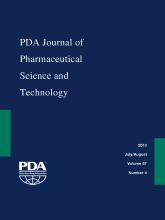Abstract
Conivaptan hydrochloride injection (Vaprisol®) was developed for the treatment of hyponatremia. Because the drug is very slightly soluble in water, pH control and cosolvency techniques were used to achieve the optimum concentration required for clinical trial material. Stability studies on retained samples of the clinical trial material for early-phase trials showed white visible particulates mainly in the headspace of the glass ampoule long after completion of the trials. The mechanism for generation of the particulate matter was formation of freebase of conivaptan hydrochloride because of increase in pH. The pH of the formulation for late-phase clinical trials, primary stability studies, and commercial production was fine-tuned to prevent particulate formation. The formulation contains propylene glycol and ethanol. Considering the nature of the cosolvent used in the formulation, the amount of di(2-ethylhexyl)phthalate (DEHP) delivered from an infusion system was evaluated, and we confirmed that the level of DEHP was lesser than that mentioned in the guideline. In the course of the scale-up studies for commercialization, the formulation failed the filter integrity test after the compounding solution was filtered. The dimethylsiloxane extracted from the silicon tubing used for solvent transfer coated the filter surface, which resulted in suppression of the bubble point value. The formulation and manufacturing process enabled conivaptan hydrochloride to be approved and launched in the market as a parenteral formulation.
LAY ABSTRACT: Formulation scientists have recognized a trend that promising new chemical entities in the drug discovery phase often do not have ideal physicochemical properties for formulation. In particular, poor solubility is one of the challenges for development of a parenteral dosage form. Here, we describe the case of such a new chemical entity, a very slightly soluble hydrochloric salt, which was handed over from a drug discovery research laboratory to a pharmaceutical laboratory. pH control and cosolvency techniques were used to achieve the optimum concentration required for the product. However, a couple of issues emerged; we performed confirmatory studies in the course of development, and the results of these studies were used to design the formulation and manufacturing process. Most prominent issues were particulate matter formation on the inner surface the headspace of the ampoule and failure of the filter integrity test. In addition, we discuss the root causes and the mechanisms of the above issues and the measures taken to prevent them. A part of them are crucial, and information obtained from this study is important for development of new chemical entities as injectables in the future.
- Conivaptan hydrochloride
- Cosolvent
- Propylene glycol
- Ethanol
- Lactic acid
- Hydrolysis
- Esterification
- Particulate matter
- Freebase
- Alkali leaching
- DEHP
- Filter integrity test
- Silicon
- © PDA, Inc. 2013
PDA members receive access to all articles published in the current year and previous volume year. Institutional subscribers received access to all content. Log in below to receive access to this article if you are either of these.
If you are neither or you are a PDA member trying to access an article outside of your membership license, then you must purchase access to this article (below). If you do not have a username or password for JPST, you will be required to create an account prior to purchasing.
Full issue PDFs are for PDA members only.
Note to pda.org users
The PDA and PDA bookstore websites (www.pda.org and www.pda.org/bookstore) are separate websites from the PDA JPST website. When you first join PDA, your initial UserID and Password are sent to HighWirePress to create your PDA JPST account. Subsequent UserrID and Password changes required at the PDA websites will not pass on to PDA JPST and vice versa. If you forget your PDA JPST UserID and/or Password, you can request help to retrieve UserID and reset Password below.






